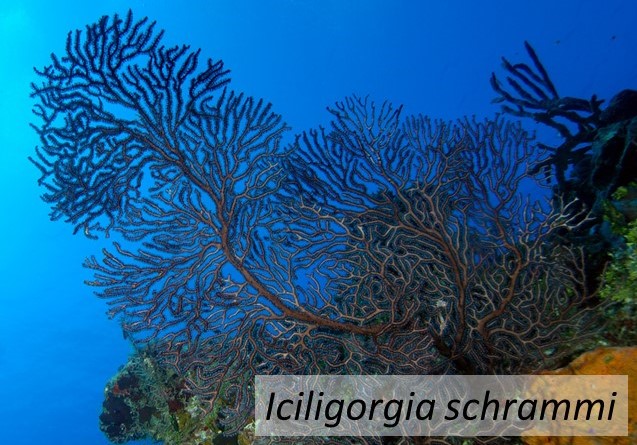
Family: Anthothelidae
Common Name(s): Deep-water sea fan, Black sea fan
Colony Form: Monoplanar stiff fan with dichotomous branches not interconnected; to ~1 m tall.
Axis: Flattened in plane of fan.
Branches: Flattened in plane of fan, dichotomous, not interconnected, 3-5 mm across. Secondary branches and unbranched twigs usually bent. Terminal twigs along fan periphery usually forked. Edges of twig ends folded over and joined so that twig tips are indented or grooved (=fistulose).
Apertures: Polyps restricted to sides of branches. Calices are low oval or slitlike mounds with eight lobes.
Mucus: None
Color: Red-brown, copper, dark brown or grey. Often appearing black in situ. Usually light brown when dried.
Sclerites: Polyp armature: flattened, slightly curved spindles to 0.5 mm long, arranged in eight series of inverted V’s (“en chevron”). Outer layer: chiefly elongate spindles 0.5–0.6 mm long, with ornamentation ranging from scattered small thorns to crowded tubercles. Inner layer: smooth to slightly warty, extremely slender needles 0.5–0.7 mm long.
Habitat: Deeper reefs, commonly along slopes, walls, crevices and canyons exposed to currents. Depth range: 3-368 m, usually below ~15 m.
Distribution: Georgia to Brazil, Bahamas, Caribbean Sea.
Notes: Unlike sea fans of genus Gorgonia, I. schrammi branchlets do not interconnect. Fans vibrate in strong currents. The indented or grooved twig tips are unique among shallow, Western Atlantic octocorals.
References: Bayer (1961), Cairns (1977), Humann and DeLoach (2002).
Similar Species: Gorgonia flabellum; Gorgonia ventalina




